Analyzing HR Function Variation Across Different Organizations
VerifiedAdded on 2022/08/09
|20
|5687
|26
Report
AI Summary
This report provides a comprehensive analysis of the human resource (HR) function within various organizational contexts. It begins by exploring the variations in HR functions across different organizations, considering factors such as size, sector, and business environment, using examples like Integrity Life and Walmart. The report then delves into organizational objectives that are directly influenced by HR, including financial success, employee retention, and continuous professional development, examining how these objectives have evolved. Furthermore, it discusses two significant methods of HR delivery: line managers and departmentalized HR. The study also evaluates the business case for ethical HR practices, change management theories, and the contribution of HR functions to organizational success. The analysis covers the impact of globalization, the importance of employer branding, and the significance of workforce planning and training. The report highlights the role of HR in fostering employee engagement, managing diversity, and ensuring compliance with labor laws, ultimately providing a detailed overview of the HR function's role in contemporary organizations.
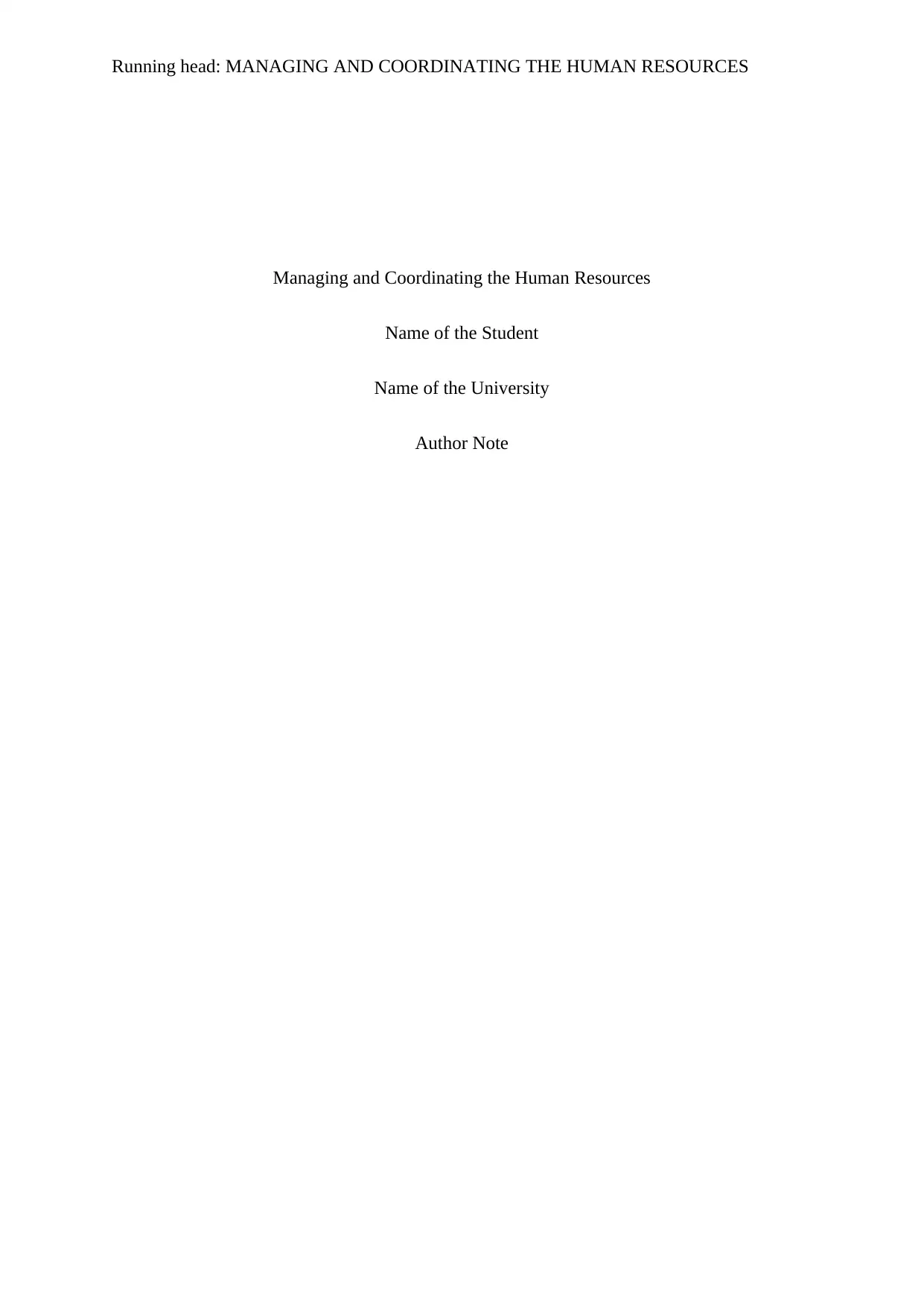
Running head: MANAGING AND COORDINATING THE HUMAN RESOURCES
Managing and Coordinating the Human Resources
Name of the Student
Name of the University
Author Note
Managing and Coordinating the Human Resources
Name of the Student
Name of the University
Author Note
Paraphrase This Document
Need a fresh take? Get an instant paraphrase of this document with our AI Paraphraser

1MANAGING AND COORDINATING THE HUMAN RESOURCES
Table of Contents
Question 1:.................................................................................................................................4
Question 2..................................................................................................................................6
Question 3:.................................................................................................................................8
Question 4:...............................................................................................................................10
Question 5:...............................................................................................................................13
Question 6:...............................................................................................................................14
References:...............................................................................................................................16
Table of Contents
Question 1:.................................................................................................................................4
Question 2..................................................................................................................................6
Question 3:.................................................................................................................................8
Question 4:...............................................................................................................................10
Question 5:...............................................................................................................................13
Question 6:...............................................................................................................................14
References:...............................................................................................................................16
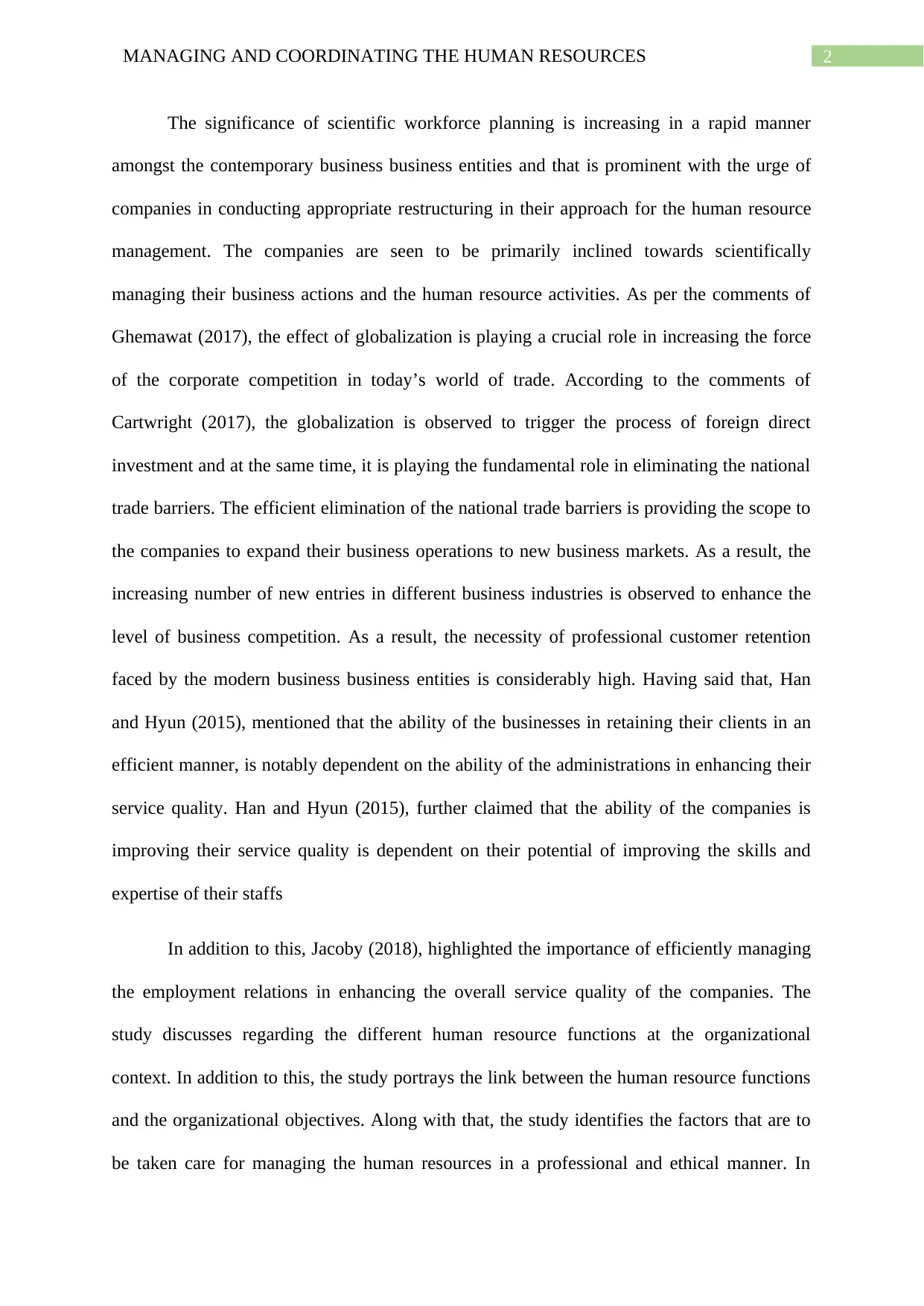
2MANAGING AND COORDINATING THE HUMAN RESOURCES
The significance of scientific workforce planning is increasing in a rapid manner
amongst the contemporary business business entities and that is prominent with the urge of
companies in conducting appropriate restructuring in their approach for the human resource
management. The companies are seen to be primarily inclined towards scientifically
managing their business actions and the human resource activities. As per the comments of
Ghemawat (2017), the effect of globalization is playing a crucial role in increasing the force
of the corporate competition in today’s world of trade. According to the comments of
Cartwright (2017), the globalization is observed to trigger the process of foreign direct
investment and at the same time, it is playing the fundamental role in eliminating the national
trade barriers. The efficient elimination of the national trade barriers is providing the scope to
the companies to expand their business operations to new business markets. As a result, the
increasing number of new entries in different business industries is observed to enhance the
level of business competition. As a result, the necessity of professional customer retention
faced by the modern business business entities is considerably high. Having said that, Han
and Hyun (2015), mentioned that the ability of the businesses in retaining their clients in an
efficient manner, is notably dependent on the ability of the administrations in enhancing their
service quality. Han and Hyun (2015), further claimed that the ability of the companies is
improving their service quality is dependent on their potential of improving the skills and
expertise of their staffs
In addition to this, Jacoby (2018), highlighted the importance of efficiently managing
the employment relations in enhancing the overall service quality of the companies. The
study discusses regarding the different human resource functions at the organizational
context. In addition to this, the study portrays the link between the human resource functions
and the organizational objectives. Along with that, the study identifies the factors that are to
be taken care for managing the human resources in a professional and ethical manner. In
The significance of scientific workforce planning is increasing in a rapid manner
amongst the contemporary business business entities and that is prominent with the urge of
companies in conducting appropriate restructuring in their approach for the human resource
management. The companies are seen to be primarily inclined towards scientifically
managing their business actions and the human resource activities. As per the comments of
Ghemawat (2017), the effect of globalization is playing a crucial role in increasing the force
of the corporate competition in today’s world of trade. According to the comments of
Cartwright (2017), the globalization is observed to trigger the process of foreign direct
investment and at the same time, it is playing the fundamental role in eliminating the national
trade barriers. The efficient elimination of the national trade barriers is providing the scope to
the companies to expand their business operations to new business markets. As a result, the
increasing number of new entries in different business industries is observed to enhance the
level of business competition. As a result, the necessity of professional customer retention
faced by the modern business business entities is considerably high. Having said that, Han
and Hyun (2015), mentioned that the ability of the businesses in retaining their clients in an
efficient manner, is notably dependent on the ability of the administrations in enhancing their
service quality. Han and Hyun (2015), further claimed that the ability of the companies is
improving their service quality is dependent on their potential of improving the skills and
expertise of their staffs
In addition to this, Jacoby (2018), highlighted the importance of efficiently managing
the employment relations in enhancing the overall service quality of the companies. The
study discusses regarding the different human resource functions at the organizational
context. In addition to this, the study portrays the link between the human resource functions
and the organizational objectives. Along with that, the study identifies the factors that are to
be taken care for managing the human resources in a professional and ethical manner. In
⊘ This is a preview!⊘
Do you want full access?
Subscribe today to unlock all pages.

Trusted by 1+ million students worldwide
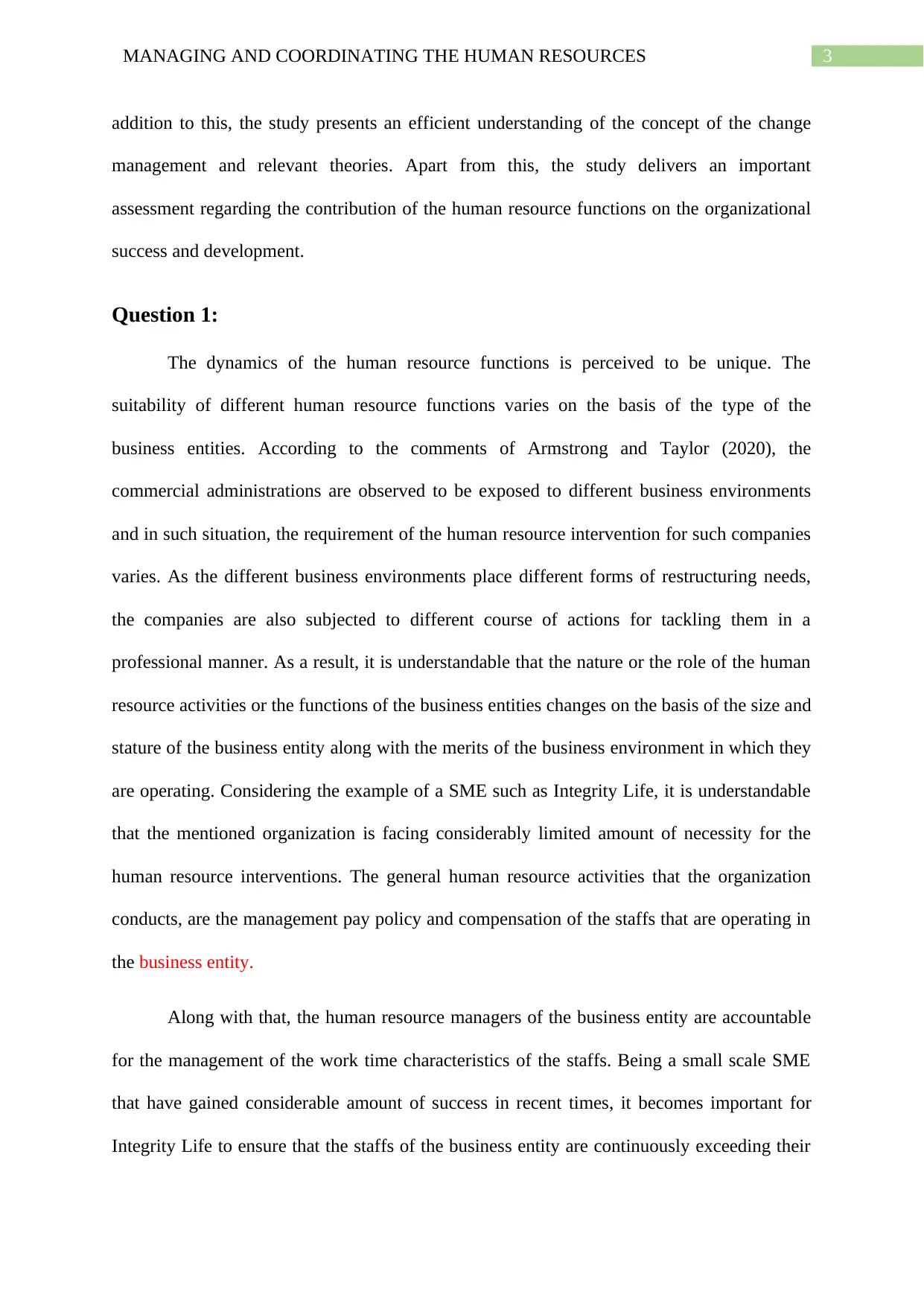
3MANAGING AND COORDINATING THE HUMAN RESOURCES
addition to this, the study presents an efficient understanding of the concept of the change
management and relevant theories. Apart from this, the study delivers an important
assessment regarding the contribution of the human resource functions on the organizational
success and development.
Question 1:
The dynamics of the human resource functions is perceived to be unique. The
suitability of different human resource functions varies on the basis of the type of the
business entities. According to the comments of Armstrong and Taylor (2020), the
commercial administrations are observed to be exposed to different business environments
and in such situation, the requirement of the human resource intervention for such companies
varies. As the different business environments place different forms of restructuring needs,
the companies are also subjected to different course of actions for tackling them in a
professional manner. As a result, it is understandable that the nature or the role of the human
resource activities or the functions of the business entities changes on the basis of the size and
stature of the business entity along with the merits of the business environment in which they
are operating. Considering the example of a SME such as Integrity Life, it is understandable
that the mentioned organization is facing considerably limited amount of necessity for the
human resource interventions. The general human resource activities that the organization
conducts, are the management pay policy and compensation of the staffs that are operating in
the business entity.
Along with that, the human resource managers of the business entity are accountable
for the management of the work time characteristics of the staffs. Being a small scale SME
that have gained considerable amount of success in recent times, it becomes important for
Integrity Life to ensure that the staffs of the business entity are continuously exceeding their
addition to this, the study presents an efficient understanding of the concept of the change
management and relevant theories. Apart from this, the study delivers an important
assessment regarding the contribution of the human resource functions on the organizational
success and development.
Question 1:
The dynamics of the human resource functions is perceived to be unique. The
suitability of different human resource functions varies on the basis of the type of the
business entities. According to the comments of Armstrong and Taylor (2020), the
commercial administrations are observed to be exposed to different business environments
and in such situation, the requirement of the human resource intervention for such companies
varies. As the different business environments place different forms of restructuring needs,
the companies are also subjected to different course of actions for tackling them in a
professional manner. As a result, it is understandable that the nature or the role of the human
resource activities or the functions of the business entities changes on the basis of the size and
stature of the business entity along with the merits of the business environment in which they
are operating. Considering the example of a SME such as Integrity Life, it is understandable
that the mentioned organization is facing considerably limited amount of necessity for the
human resource interventions. The general human resource activities that the organization
conducts, are the management pay policy and compensation of the staffs that are operating in
the business entity.
Along with that, the human resource managers of the business entity are accountable
for the management of the work time characteristics of the staffs. Being a small scale SME
that have gained considerable amount of success in recent times, it becomes important for
Integrity Life to ensure that the staffs of the business entity are continuously exceeding their
Paraphrase This Document
Need a fresh take? Get an instant paraphrase of this document with our AI Paraphraser
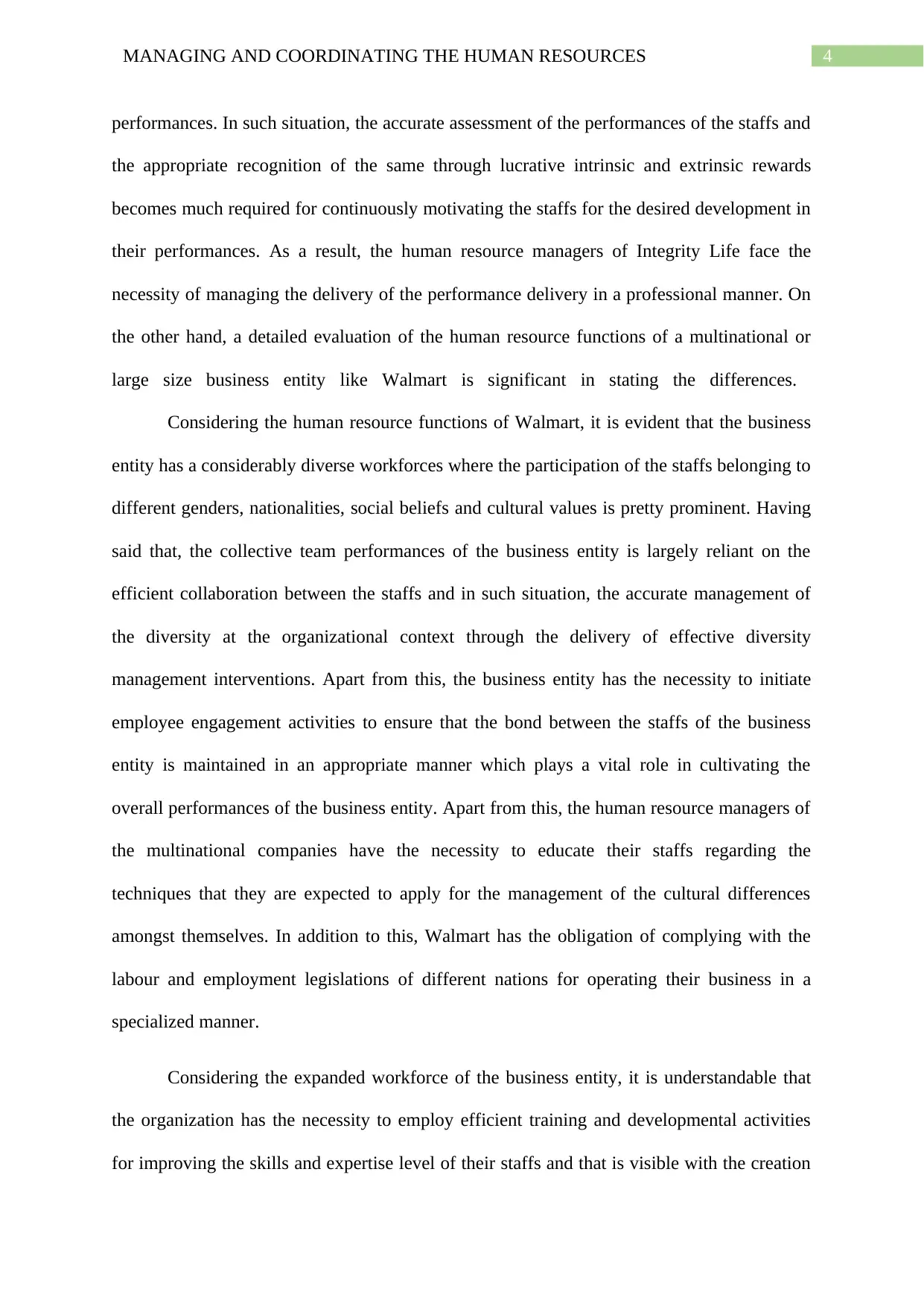
4MANAGING AND COORDINATING THE HUMAN RESOURCES
performances. In such situation, the accurate assessment of the performances of the staffs and
the appropriate recognition of the same through lucrative intrinsic and extrinsic rewards
becomes much required for continuously motivating the staffs for the desired development in
their performances. As a result, the human resource managers of Integrity Life face the
necessity of managing the delivery of the performance delivery in a professional manner. On
the other hand, a detailed evaluation of the human resource functions of a multinational or
large size business entity like Walmart is significant in stating the differences.
Considering the human resource functions of Walmart, it is evident that the business
entity has a considerably diverse workforces where the participation of the staffs belonging to
different genders, nationalities, social beliefs and cultural values is pretty prominent. Having
said that, the collective team performances of the business entity is largely reliant on the
efficient collaboration between the staffs and in such situation, the accurate management of
the diversity at the organizational context through the delivery of effective diversity
management interventions. Apart from this, the business entity has the necessity to initiate
employee engagement activities to ensure that the bond between the staffs of the business
entity is maintained in an appropriate manner which plays a vital role in cultivating the
overall performances of the business entity. Apart from this, the human resource managers of
the multinational companies have the necessity to educate their staffs regarding the
techniques that they are expected to apply for the management of the cultural differences
amongst themselves. In addition to this, Walmart has the obligation of complying with the
labour and employment legislations of different nations for operating their business in a
specialized manner.
Considering the expanded workforce of the business entity, it is understandable that
the organization has the necessity to employ efficient training and developmental activities
for improving the skills and expertise level of their staffs and that is visible with the creation
performances. In such situation, the accurate assessment of the performances of the staffs and
the appropriate recognition of the same through lucrative intrinsic and extrinsic rewards
becomes much required for continuously motivating the staffs for the desired development in
their performances. As a result, the human resource managers of Integrity Life face the
necessity of managing the delivery of the performance delivery in a professional manner. On
the other hand, a detailed evaluation of the human resource functions of a multinational or
large size business entity like Walmart is significant in stating the differences.
Considering the human resource functions of Walmart, it is evident that the business
entity has a considerably diverse workforces where the participation of the staffs belonging to
different genders, nationalities, social beliefs and cultural values is pretty prominent. Having
said that, the collective team performances of the business entity is largely reliant on the
efficient collaboration between the staffs and in such situation, the accurate management of
the diversity at the organizational context through the delivery of effective diversity
management interventions. Apart from this, the business entity has the necessity to initiate
employee engagement activities to ensure that the bond between the staffs of the business
entity is maintained in an appropriate manner which plays a vital role in cultivating the
overall performances of the business entity. Apart from this, the human resource managers of
the multinational companies have the necessity to educate their staffs regarding the
techniques that they are expected to apply for the management of the cultural differences
amongst themselves. In addition to this, Walmart has the obligation of complying with the
labour and employment legislations of different nations for operating their business in a
specialized manner.
Considering the expanded workforce of the business entity, it is understandable that
the organization has the necessity to employ efficient training and developmental activities
for improving the skills and expertise level of their staffs and that is visible with the creation
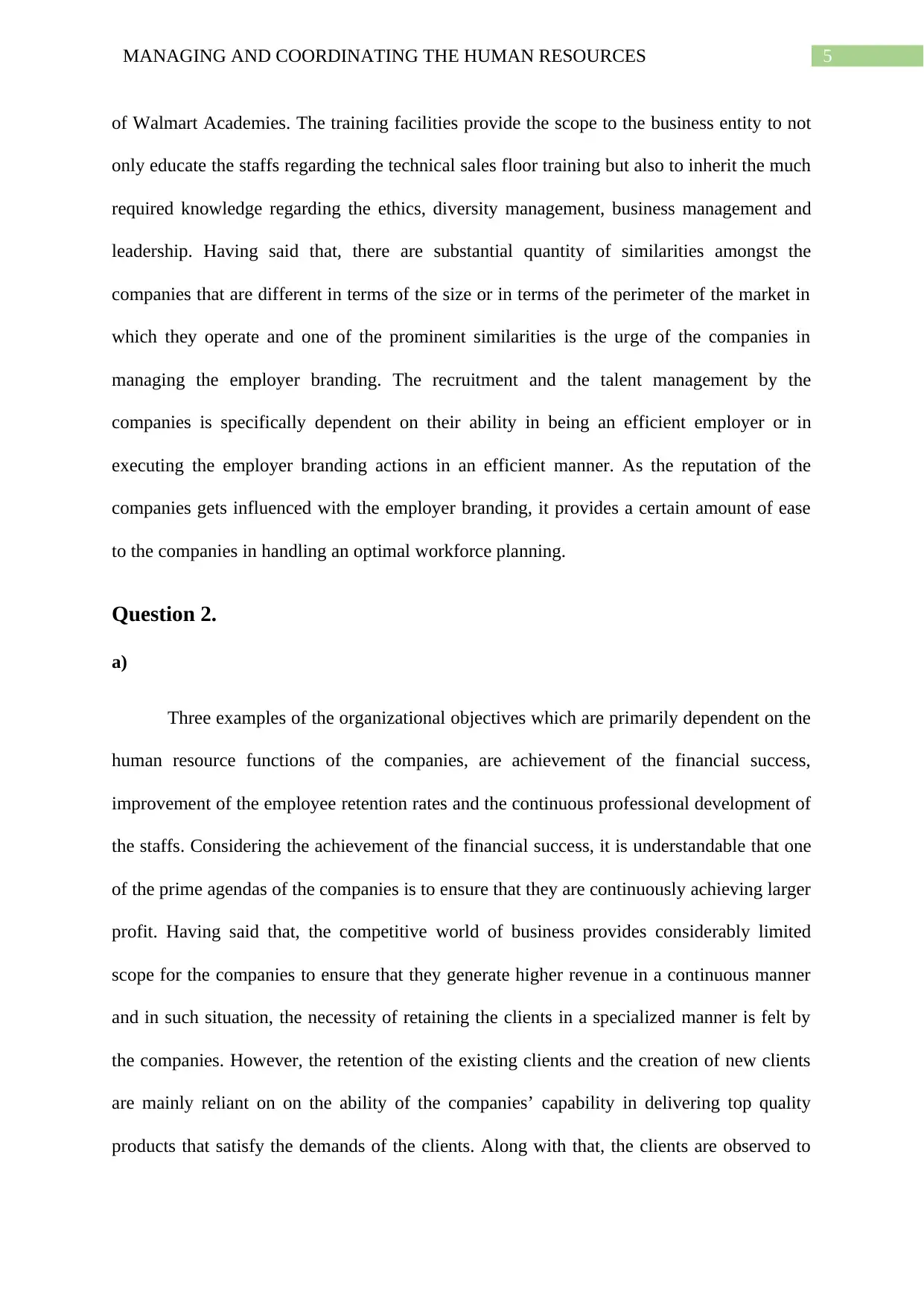
5MANAGING AND COORDINATING THE HUMAN RESOURCES
of Walmart Academies. The training facilities provide the scope to the business entity to not
only educate the staffs regarding the technical sales floor training but also to inherit the much
required knowledge regarding the ethics, diversity management, business management and
leadership. Having said that, there are substantial quantity of similarities amongst the
companies that are different in terms of the size or in terms of the perimeter of the market in
which they operate and one of the prominent similarities is the urge of the companies in
managing the employer branding. The recruitment and the talent management by the
companies is specifically dependent on their ability in being an efficient employer or in
executing the employer branding actions in an efficient manner. As the reputation of the
companies gets influenced with the employer branding, it provides a certain amount of ease
to the companies in handling an optimal workforce planning.
Question 2.
a)
Three examples of the organizational objectives which are primarily dependent on the
human resource functions of the companies, are achievement of the financial success,
improvement of the employee retention rates and the continuous professional development of
the staffs. Considering the achievement of the financial success, it is understandable that one
of the prime agendas of the companies is to ensure that they are continuously achieving larger
profit. Having said that, the competitive world of business provides considerably limited
scope for the companies to ensure that they generate higher revenue in a continuous manner
and in such situation, the necessity of retaining the clients in a specialized manner is felt by
the companies. However, the retention of the existing clients and the creation of new clients
are mainly reliant on on the ability of the companies’ capability in delivering top quality
products that satisfy the demands of the clients. Along with that, the clients are observed to
of Walmart Academies. The training facilities provide the scope to the business entity to not
only educate the staffs regarding the technical sales floor training but also to inherit the much
required knowledge regarding the ethics, diversity management, business management and
leadership. Having said that, there are substantial quantity of similarities amongst the
companies that are different in terms of the size or in terms of the perimeter of the market in
which they operate and one of the prominent similarities is the urge of the companies in
managing the employer branding. The recruitment and the talent management by the
companies is specifically dependent on their ability in being an efficient employer or in
executing the employer branding actions in an efficient manner. As the reputation of the
companies gets influenced with the employer branding, it provides a certain amount of ease
to the companies in handling an optimal workforce planning.
Question 2.
a)
Three examples of the organizational objectives which are primarily dependent on the
human resource functions of the companies, are achievement of the financial success,
improvement of the employee retention rates and the continuous professional development of
the staffs. Considering the achievement of the financial success, it is understandable that one
of the prime agendas of the companies is to ensure that they are continuously achieving larger
profit. Having said that, the competitive world of business provides considerably limited
scope for the companies to ensure that they generate higher revenue in a continuous manner
and in such situation, the necessity of retaining the clients in a specialized manner is felt by
the companies. However, the retention of the existing clients and the creation of new clients
are mainly reliant on on the ability of the companies’ capability in delivering top quality
products that satisfy the demands of the clients. Along with that, the clients are observed to
⊘ This is a preview!⊘
Do you want full access?
Subscribe today to unlock all pages.

Trusted by 1+ million students worldwide
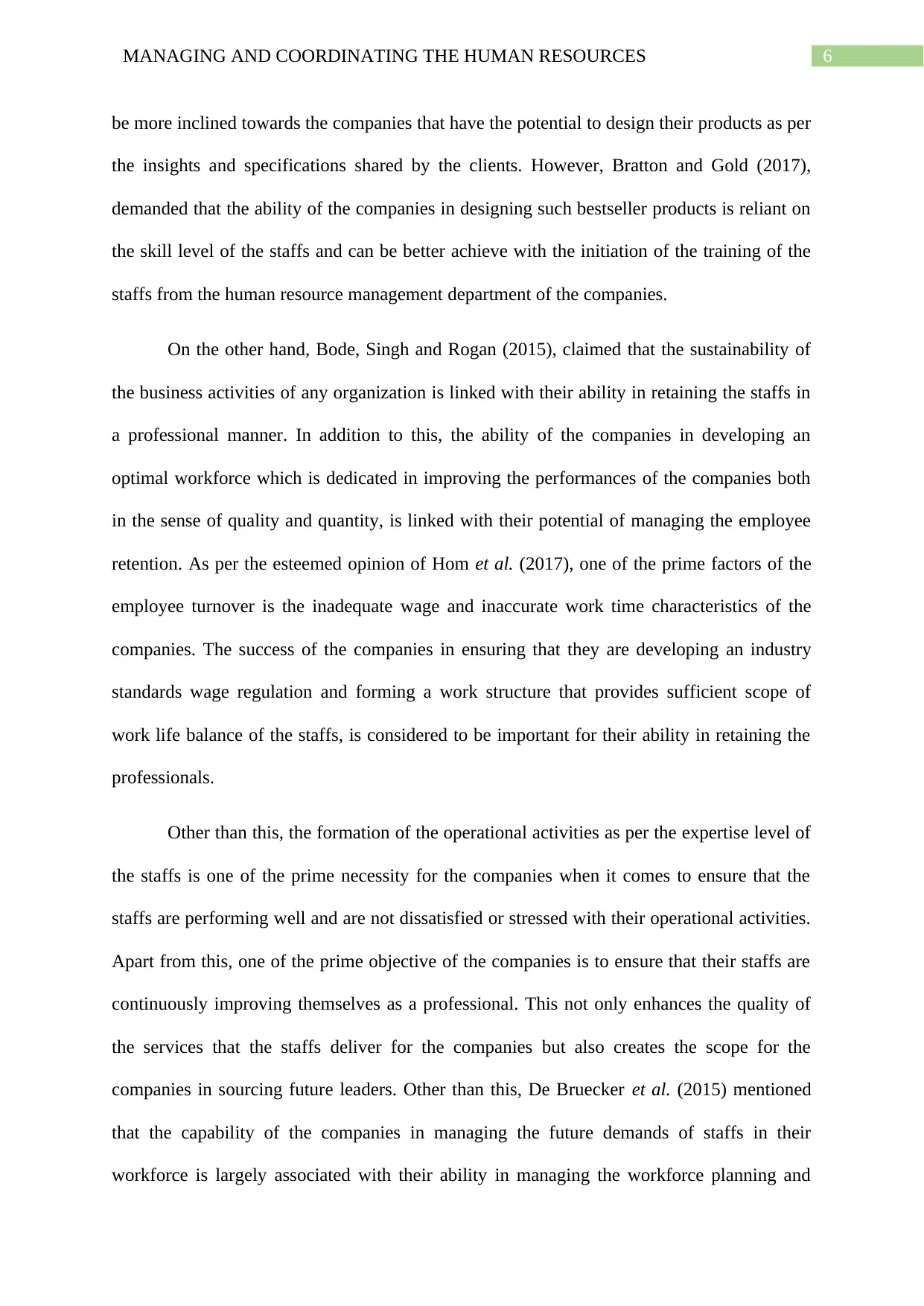
6MANAGING AND COORDINATING THE HUMAN RESOURCES
be more inclined towards the companies that have the potential to design their products as per
the insights and specifications shared by the clients. However, Bratton and Gold (2017),
demanded that the ability of the companies in designing such bestseller products is reliant on
the skill level of the staffs and can be better achieve with the initiation of the training of the
staffs from the human resource management department of the companies.
On the other hand, Bode, Singh and Rogan (2015), claimed that the sustainability of
the business activities of any organization is linked with their ability in retaining the staffs in
a professional manner. In addition to this, the ability of the companies in developing an
optimal workforce which is dedicated in improving the performances of the companies both
in the sense of quality and quantity, is linked with their potential of managing the employee
retention. As per the esteemed opinion of Hom et al. (2017), one of the prime factors of the
employee turnover is the inadequate wage and inaccurate work time characteristics of the
companies. The success of the companies in ensuring that they are developing an industry
standards wage regulation and forming a work structure that provides sufficient scope of
work life balance of the staffs, is considered to be important for their ability in retaining the
professionals.
Other than this, the formation of the operational activities as per the expertise level of
the staffs is one of the prime necessity for the companies when it comes to ensure that the
staffs are performing well and are not dissatisfied or stressed with their operational activities.
Apart from this, one of the prime objective of the companies is to ensure that their staffs are
continuously improving themselves as a professional. This not only enhances the quality of
the services that the staffs deliver for the companies but also creates the scope for the
companies in sourcing future leaders. Other than this, De Bruecker et al. (2015) mentioned
that the capability of the companies in managing the future demands of staffs in their
workforce is largely associated with their ability in managing the workforce planning and
be more inclined towards the companies that have the potential to design their products as per
the insights and specifications shared by the clients. However, Bratton and Gold (2017),
demanded that the ability of the companies in designing such bestseller products is reliant on
the skill level of the staffs and can be better achieve with the initiation of the training of the
staffs from the human resource management department of the companies.
On the other hand, Bode, Singh and Rogan (2015), claimed that the sustainability of
the business activities of any organization is linked with their ability in retaining the staffs in
a professional manner. In addition to this, the ability of the companies in developing an
optimal workforce which is dedicated in improving the performances of the companies both
in the sense of quality and quantity, is linked with their potential of managing the employee
retention. As per the esteemed opinion of Hom et al. (2017), one of the prime factors of the
employee turnover is the inadequate wage and inaccurate work time characteristics of the
companies. The success of the companies in ensuring that they are developing an industry
standards wage regulation and forming a work structure that provides sufficient scope of
work life balance of the staffs, is considered to be important for their ability in retaining the
professionals.
Other than this, the formation of the operational activities as per the expertise level of
the staffs is one of the prime necessity for the companies when it comes to ensure that the
staffs are performing well and are not dissatisfied or stressed with their operational activities.
Apart from this, one of the prime objective of the companies is to ensure that their staffs are
continuously improving themselves as a professional. This not only enhances the quality of
the services that the staffs deliver for the companies but also creates the scope for the
companies in sourcing future leaders. Other than this, De Bruecker et al. (2015) mentioned
that the capability of the companies in managing the future demands of staffs in their
workforce is largely associated with their ability in managing the workforce planning and
Paraphrase This Document
Need a fresh take? Get an instant paraphrase of this document with our AI Paraphraser
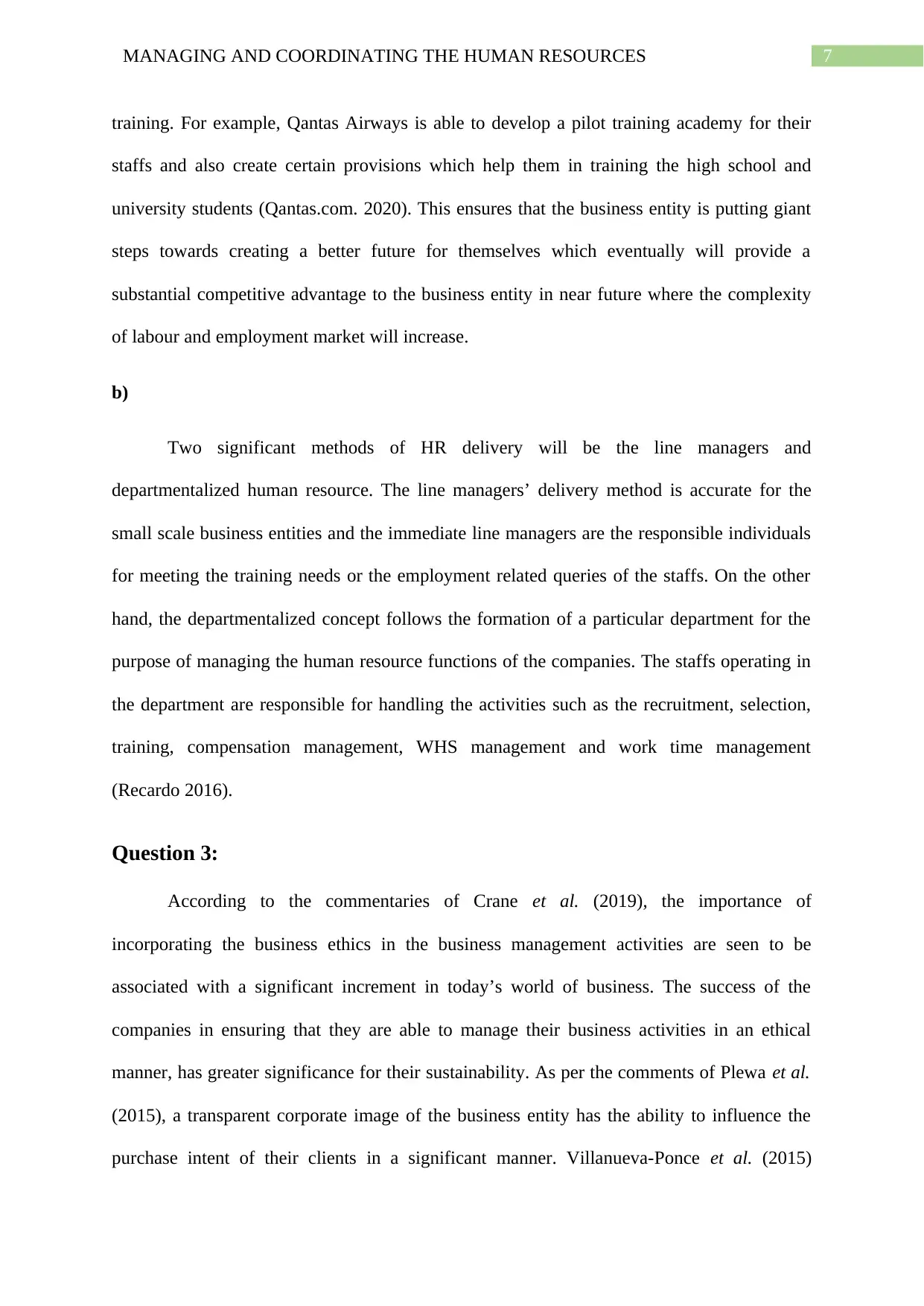
7MANAGING AND COORDINATING THE HUMAN RESOURCES
training. For example, Qantas Airways is able to develop a pilot training academy for their
staffs and also create certain provisions which help them in training the high school and
university students (Qantas.com. 2020). This ensures that the business entity is putting giant
steps towards creating a better future for themselves which eventually will provide a
substantial competitive advantage to the business entity in near future where the complexity
of labour and employment market will increase.
b)
Two significant methods of HR delivery will be the line managers and
departmentalized human resource. The line managers’ delivery method is accurate for the
small scale business entities and the immediate line managers are the responsible individuals
for meeting the training needs or the employment related queries of the staffs. On the other
hand, the departmentalized concept follows the formation of a particular department for the
purpose of managing the human resource functions of the companies. The staffs operating in
the department are responsible for handling the activities such as the recruitment, selection,
training, compensation management, WHS management and work time management
(Recardo 2016).
Question 3:
According to the commentaries of Crane et al. (2019), the importance of
incorporating the business ethics in the business management activities are seen to be
associated with a significant increment in today’s world of business. The success of the
companies in ensuring that they are able to manage their business activities in an ethical
manner, has greater significance for their sustainability. As per the comments of Plewa et al.
(2015), a transparent corporate image of the business entity has the ability to influence the
purchase intent of their clients in a significant manner. Villanueva-Ponce et al. (2015)
training. For example, Qantas Airways is able to develop a pilot training academy for their
staffs and also create certain provisions which help them in training the high school and
university students (Qantas.com. 2020). This ensures that the business entity is putting giant
steps towards creating a better future for themselves which eventually will provide a
substantial competitive advantage to the business entity in near future where the complexity
of labour and employment market will increase.
b)
Two significant methods of HR delivery will be the line managers and
departmentalized human resource. The line managers’ delivery method is accurate for the
small scale business entities and the immediate line managers are the responsible individuals
for meeting the training needs or the employment related queries of the staffs. On the other
hand, the departmentalized concept follows the formation of a particular department for the
purpose of managing the human resource functions of the companies. The staffs operating in
the department are responsible for handling the activities such as the recruitment, selection,
training, compensation management, WHS management and work time management
(Recardo 2016).
Question 3:
According to the commentaries of Crane et al. (2019), the importance of
incorporating the business ethics in the business management activities are seen to be
associated with a significant increment in today’s world of business. The success of the
companies in ensuring that they are able to manage their business activities in an ethical
manner, has greater significance for their sustainability. As per the comments of Plewa et al.
(2015), a transparent corporate image of the business entity has the ability to influence the
purchase intent of their clients in a significant manner. Villanueva-Ponce et al. (2015)
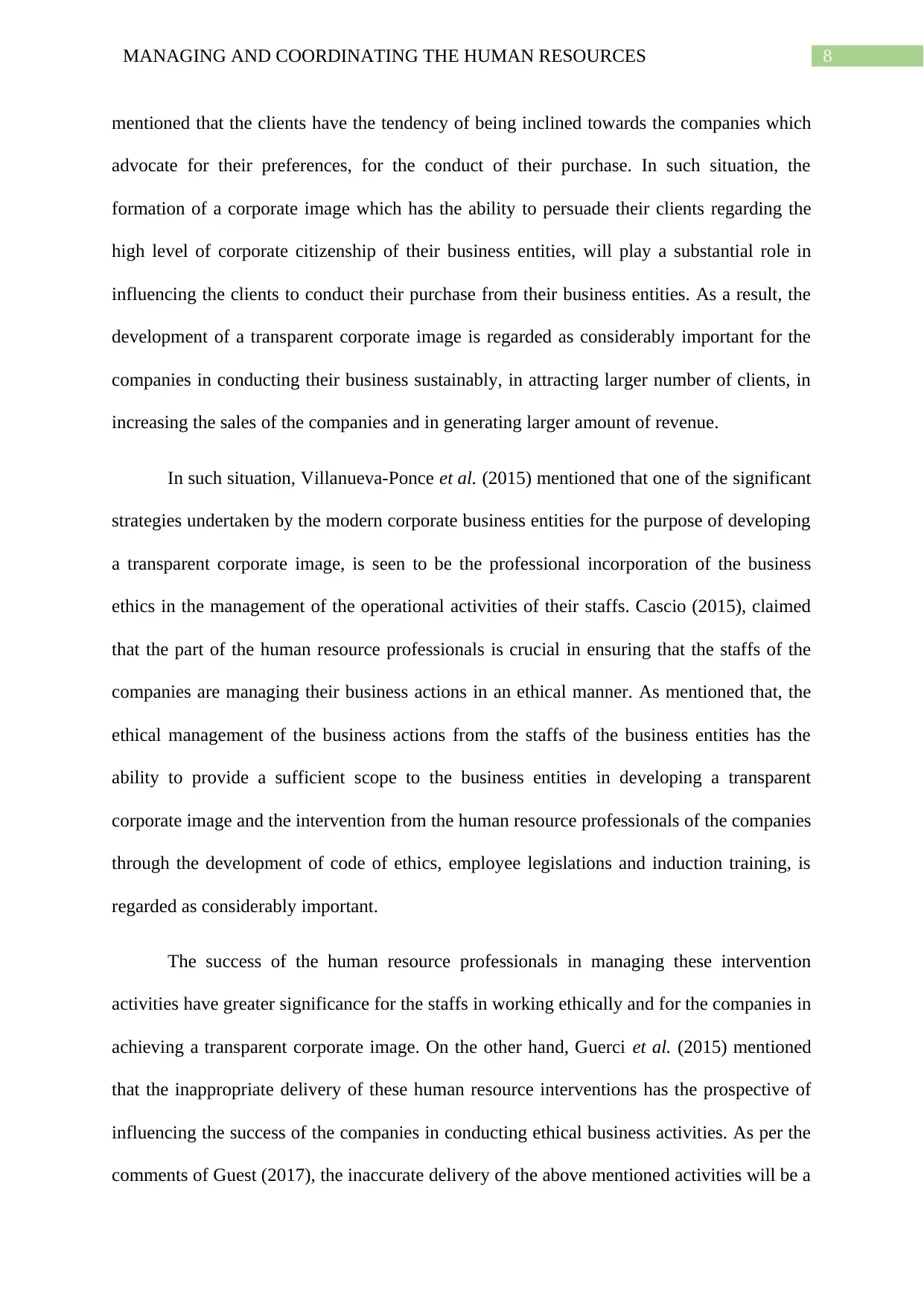
8MANAGING AND COORDINATING THE HUMAN RESOURCES
mentioned that the clients have the tendency of being inclined towards the companies which
advocate for their preferences, for the conduct of their purchase. In such situation, the
formation of a corporate image which has the ability to persuade their clients regarding the
high level of corporate citizenship of their business entities, will play a substantial role in
influencing the clients to conduct their purchase from their business entities. As a result, the
development of a transparent corporate image is regarded as considerably important for the
companies in conducting their business sustainably, in attracting larger number of clients, in
increasing the sales of the companies and in generating larger amount of revenue.
In such situation, Villanueva-Ponce et al. (2015) mentioned that one of the significant
strategies undertaken by the modern corporate business entities for the purpose of developing
a transparent corporate image, is seen to be the professional incorporation of the business
ethics in the management of the operational activities of their staffs. Cascio (2015), claimed
that the part of the human resource professionals is crucial in ensuring that the staffs of the
companies are managing their business actions in an ethical manner. As mentioned that, the
ethical management of the business actions from the staffs of the business entities has the
ability to provide a sufficient scope to the business entities in developing a transparent
corporate image and the intervention from the human resource professionals of the companies
through the development of code of ethics, employee legislations and induction training, is
regarded as considerably important.
The success of the human resource professionals in managing these intervention
activities have greater significance for the staffs in working ethically and for the companies in
achieving a transparent corporate image. On the other hand, Guerci et al. (2015) mentioned
that the inappropriate delivery of these human resource interventions has the prospective of
influencing the success of the companies in conducting ethical business activities. As per the
comments of Guest (2017), the inaccurate delivery of the above mentioned activities will be a
mentioned that the clients have the tendency of being inclined towards the companies which
advocate for their preferences, for the conduct of their purchase. In such situation, the
formation of a corporate image which has the ability to persuade their clients regarding the
high level of corporate citizenship of their business entities, will play a substantial role in
influencing the clients to conduct their purchase from their business entities. As a result, the
development of a transparent corporate image is regarded as considerably important for the
companies in conducting their business sustainably, in attracting larger number of clients, in
increasing the sales of the companies and in generating larger amount of revenue.
In such situation, Villanueva-Ponce et al. (2015) mentioned that one of the significant
strategies undertaken by the modern corporate business entities for the purpose of developing
a transparent corporate image, is seen to be the professional incorporation of the business
ethics in the management of the operational activities of their staffs. Cascio (2015), claimed
that the part of the human resource professionals is crucial in ensuring that the staffs of the
companies are managing their business actions in an ethical manner. As mentioned that, the
ethical management of the business actions from the staffs of the business entities has the
ability to provide a sufficient scope to the business entities in developing a transparent
corporate image and the intervention from the human resource professionals of the companies
through the development of code of ethics, employee legislations and induction training, is
regarded as considerably important.
The success of the human resource professionals in managing these intervention
activities have greater significance for the staffs in working ethically and for the companies in
achieving a transparent corporate image. On the other hand, Guerci et al. (2015) mentioned
that the inappropriate delivery of these human resource interventions has the prospective of
influencing the success of the companies in conducting ethical business activities. As per the
comments of Guest (2017), the inaccurate delivery of the above mentioned activities will be a
⊘ This is a preview!⊘
Do you want full access?
Subscribe today to unlock all pages.

Trusted by 1+ million students worldwide

9MANAGING AND COORDINATING THE HUMAN RESOURCES
major challenge for the companies in enhancing the knowledge of their staffs regarding the
importance of the business ethics and the significance of the same in handling the business
actions. As a result, the companies have the possibility of facing reputational damage along
with the monetary penalization for the unethical management of the business actions of their
staffs.
According to the comments of Dietz et al. (2015), the achievement of the human
resource professionals in handling their business activities in a specialized manner is largely
dependent on their ability in avoiding the cases of discrimination. The staffs should not be
discriminated on the basis of their race, culture, social belief or the language by the human
resource professionals. At the same time, the human resource professionals are required to
ensure that they hold the credibility and accountability of their operational activities within
the organization. In addition to this, the human resource professionals are in need to manage
their business activities in such a manner that it provides equal opportunity to all their
existing and probable staffs. The recruitment and the retention activities of the business entity
are required to be managed in such a manner that it provides equal opportunity to all the
staffs.
Question 4:
Two of the most important theories related to the administration of the organizational
change, are observed to be the Kotter’s change model and McKinsey 7S Change Model. With
a close consideration towards the concept of the organizational change, Tidd and Bessant
(2018), mentioned that the concept refers the modification of the structural relationships and
the role of the people in an organization. As per the comment of Cameron and Green (2019),
the modern business environment is changing in a frequent manner and in such situation, the
success of the business organizations in confronting the change of the business environment
major challenge for the companies in enhancing the knowledge of their staffs regarding the
importance of the business ethics and the significance of the same in handling the business
actions. As a result, the companies have the possibility of facing reputational damage along
with the monetary penalization for the unethical management of the business actions of their
staffs.
According to the comments of Dietz et al. (2015), the achievement of the human
resource professionals in handling their business activities in a specialized manner is largely
dependent on their ability in avoiding the cases of discrimination. The staffs should not be
discriminated on the basis of their race, culture, social belief or the language by the human
resource professionals. At the same time, the human resource professionals are required to
ensure that they hold the credibility and accountability of their operational activities within
the organization. In addition to this, the human resource professionals are in need to manage
their business activities in such a manner that it provides equal opportunity to all their
existing and probable staffs. The recruitment and the retention activities of the business entity
are required to be managed in such a manner that it provides equal opportunity to all the
staffs.
Question 4:
Two of the most important theories related to the administration of the organizational
change, are observed to be the Kotter’s change model and McKinsey 7S Change Model. With
a close consideration towards the concept of the organizational change, Tidd and Bessant
(2018), mentioned that the concept refers the modification of the structural relationships and
the role of the people in an organization. As per the comment of Cameron and Green (2019),
the modern business environment is changing in a frequent manner and in such situation, the
success of the business organizations in confronting the change of the business environment
Paraphrase This Document
Need a fresh take? Get an instant paraphrase of this document with our AI Paraphraser
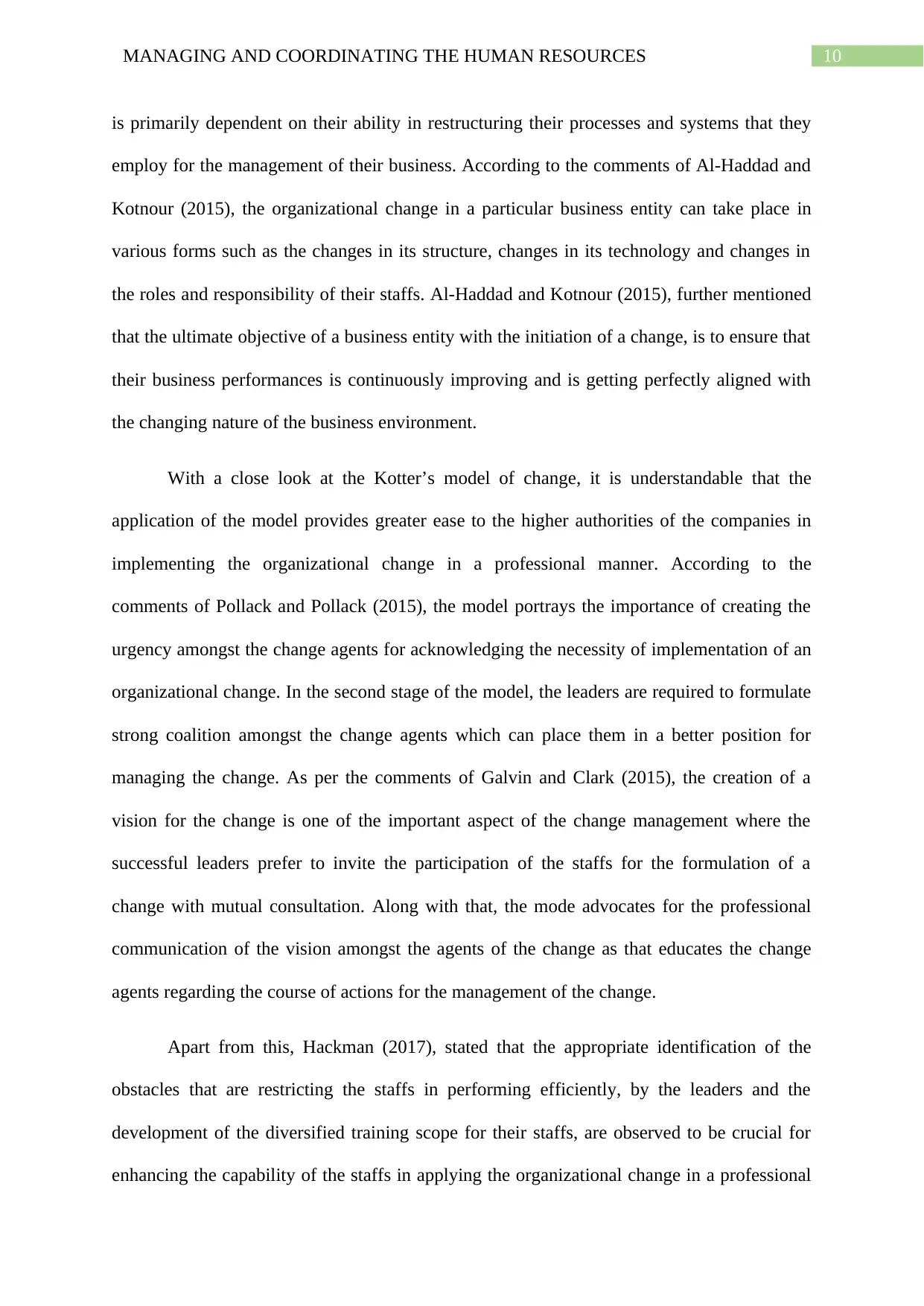
10MANAGING AND COORDINATING THE HUMAN RESOURCES
is primarily dependent on their ability in restructuring their processes and systems that they
employ for the management of their business. According to the comments of Al-Haddad and
Kotnour (2015), the organizational change in a particular business entity can take place in
various forms such as the changes in its structure, changes in its technology and changes in
the roles and responsibility of their staffs. Al-Haddad and Kotnour (2015), further mentioned
that the ultimate objective of a business entity with the initiation of a change, is to ensure that
their business performances is continuously improving and is getting perfectly aligned with
the changing nature of the business environment.
With a close look at the Kotter’s model of change, it is understandable that the
application of the model provides greater ease to the higher authorities of the companies in
implementing the organizational change in a professional manner. According to the
comments of Pollack and Pollack (2015), the model portrays the importance of creating the
urgency amongst the change agents for acknowledging the necessity of implementation of an
organizational change. In the second stage of the model, the leaders are required to formulate
strong coalition amongst the change agents which can place them in a better position for
managing the change. As per the comments of Galvin and Clark (2015), the creation of a
vision for the change is one of the important aspect of the change management where the
successful leaders prefer to invite the participation of the staffs for the formulation of a
change with mutual consultation. Along with that, the mode advocates for the professional
communication of the vision amongst the agents of the change as that educates the change
agents regarding the course of actions for the management of the change.
Apart from this, Hackman (2017), stated that the appropriate identification of the
obstacles that are restricting the staffs in performing efficiently, by the leaders and the
development of the diversified training scope for their staffs, are observed to be crucial for
enhancing the capability of the staffs in applying the organizational change in a professional
is primarily dependent on their ability in restructuring their processes and systems that they
employ for the management of their business. According to the comments of Al-Haddad and
Kotnour (2015), the organizational change in a particular business entity can take place in
various forms such as the changes in its structure, changes in its technology and changes in
the roles and responsibility of their staffs. Al-Haddad and Kotnour (2015), further mentioned
that the ultimate objective of a business entity with the initiation of a change, is to ensure that
their business performances is continuously improving and is getting perfectly aligned with
the changing nature of the business environment.
With a close look at the Kotter’s model of change, it is understandable that the
application of the model provides greater ease to the higher authorities of the companies in
implementing the organizational change in a professional manner. According to the
comments of Pollack and Pollack (2015), the model portrays the importance of creating the
urgency amongst the change agents for acknowledging the necessity of implementation of an
organizational change. In the second stage of the model, the leaders are required to formulate
strong coalition amongst the change agents which can place them in a better position for
managing the change. As per the comments of Galvin and Clark (2015), the creation of a
vision for the change is one of the important aspect of the change management where the
successful leaders prefer to invite the participation of the staffs for the formulation of a
change with mutual consultation. Along with that, the mode advocates for the professional
communication of the vision amongst the agents of the change as that educates the change
agents regarding the course of actions for the management of the change.
Apart from this, Hackman (2017), stated that the appropriate identification of the
obstacles that are restricting the staffs in performing efficiently, by the leaders and the
development of the diversified training scope for their staffs, are observed to be crucial for
enhancing the capability of the staffs in applying the organizational change in a professional

11MANAGING AND COORDINATING THE HUMAN RESOURCES
manner. Other than this, the significance of creating short term goals for the achievement of
the vision of the change, the celebration for the achievement of the short term goals, the
recognition of the good work of the staffs in implementing the change through attractive
rewards and anchoring the change in the corporate culture of the organization, is notably high
amongst the business leaders of the companies.
Considering the McKinsey 7S Change Model, Ravanfar (2015), mentioned that the
main objectives of the companies in implementing the organizational change are the
improvement of the organizational performances, alignment of the companies with their
probable future, better management of the teams along with the professional management of
the business expansion. Channon and Caldart (2015), mentioned that the model is divided
into seven different aspects which are strategy, structure, systems, shared values,, style, staff
and skills, The aspects such as the strategy, structure and systems are recognized as hard
elements whereas the shared values,, style, staff and skills are recognized as the soft
elements. According to the comments of Baishya (2015), strategy manages the plan of action
for the change, structure refers to the organizational structure for the change, systems
includes the operational activities during the change, shared values reflects the common goals
and core values of the business entities for the change, style is focused on the leadership
characteristics during the change, the aspect staff analyses the capabilities of the staffs in
managing the change and the skills reflects the requirement of expertise of the staffs and the
executives for the management of the change.
Considering the example of the change in an organization, the transformation to the
digitalised format of the record keeping from the traditional pen and paper method of record
keeping. The implementation of the change was conducted with the application of the
Kotter’s model of organizational change where the higher authority of the business entity
understood the urgency associated with the transformation and incorporated the same
manner. Other than this, the significance of creating short term goals for the achievement of
the vision of the change, the celebration for the achievement of the short term goals, the
recognition of the good work of the staffs in implementing the change through attractive
rewards and anchoring the change in the corporate culture of the organization, is notably high
amongst the business leaders of the companies.
Considering the McKinsey 7S Change Model, Ravanfar (2015), mentioned that the
main objectives of the companies in implementing the organizational change are the
improvement of the organizational performances, alignment of the companies with their
probable future, better management of the teams along with the professional management of
the business expansion. Channon and Caldart (2015), mentioned that the model is divided
into seven different aspects which are strategy, structure, systems, shared values,, style, staff
and skills, The aspects such as the strategy, structure and systems are recognized as hard
elements whereas the shared values,, style, staff and skills are recognized as the soft
elements. According to the comments of Baishya (2015), strategy manages the plan of action
for the change, structure refers to the organizational structure for the change, systems
includes the operational activities during the change, shared values reflects the common goals
and core values of the business entities for the change, style is focused on the leadership
characteristics during the change, the aspect staff analyses the capabilities of the staffs in
managing the change and the skills reflects the requirement of expertise of the staffs and the
executives for the management of the change.
Considering the example of the change in an organization, the transformation to the
digitalised format of the record keeping from the traditional pen and paper method of record
keeping. The implementation of the change was conducted with the application of the
Kotter’s model of organizational change where the higher authority of the business entity
understood the urgency associated with the transformation and incorporated the same
⊘ This is a preview!⊘
Do you want full access?
Subscribe today to unlock all pages.

Trusted by 1+ million students worldwide
1 out of 20
Related Documents
Your All-in-One AI-Powered Toolkit for Academic Success.
+13062052269
info@desklib.com
Available 24*7 on WhatsApp / Email
![[object Object]](/_next/static/media/star-bottom.7253800d.svg)
Unlock your academic potential
Copyright © 2020–2025 A2Z Services. All Rights Reserved. Developed and managed by ZUCOL.





